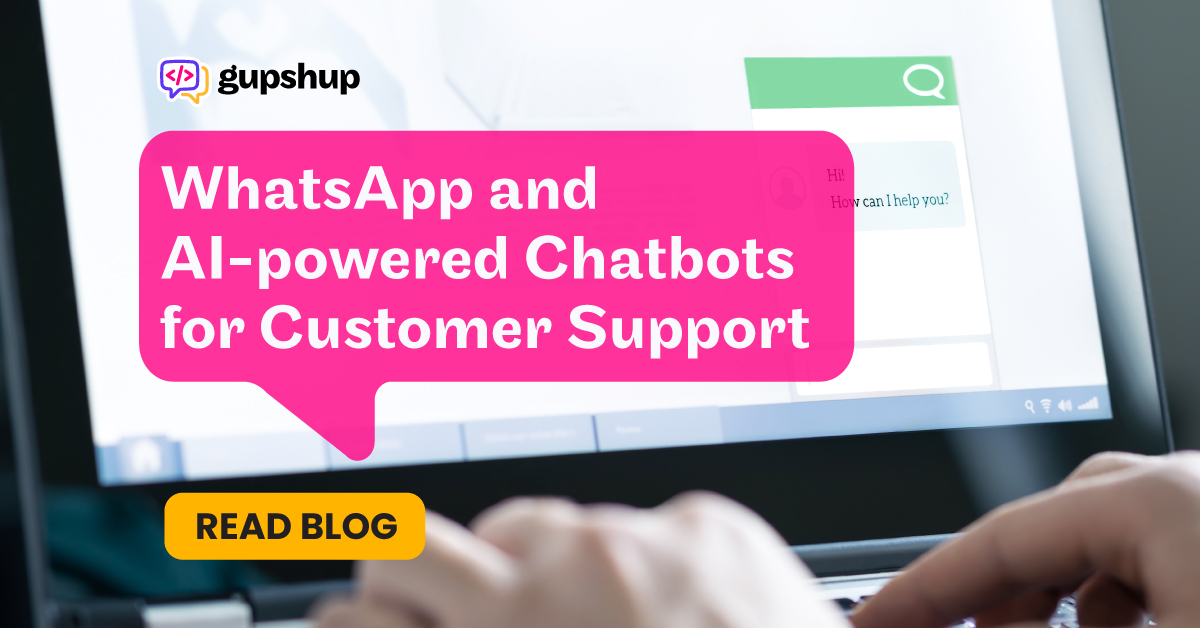WhatsApp and AI-powered Chatbots for Customer Support

In the modern hyper-digital, hyper-connected world, automation simplifies tasks, streamlines processes, and generally makes life easier for individuals and organisations alike. AI-powered chatbots are becoming more and more prevalent in the customer experience (CX) and customer support lifecycle. From a business perspective, automation provides the following benefits:
- More than 80 per cent of customer relationships in an organisation can be maintained with little or no human interaction using tools like WhatApp chatbot and AI-powered chatbots.
- Over 50 per cent of the business operations in the U.S. have depicted the potential to be automated and provide extensive benefits
- Automation can also increase and enhance productivity up to 1.5 per cent annually at the global level.
Customer Support streamlined with Chatbots and Humans
Business-customer interactions are already becoming highly automated and driven by the latest technologies for faster, precise and convenient interactions, with technologies like WhatsApp chatbots. WhatsApp chatbots and other AI-powered chatbots make it easy to implement automated yet contextual replies for specific customer queries, which not only saves time for them, but also reduces customer support cost for the organisation. The best way to utilise chatbots in a customer support function is by balancing automated interactions with human interactions. This means bots would resolve general or common queries with automated conversations, while customer support agents provide tailored support for specific, non-generic queries.
Best Practices to Set up a Balanced Chatbot-based Customer Support Ecosystem
To develop a customer support environment that has the optimal balance of both bots and human resources, organisations should taken into consideration the following aspects:
- The prioritisation of chatbot integration should be on the basis of its likelihood of generating successful outcomes . This evaluation should be conducted by first reviewing current customer support processes, and then creating a heat map identifying the areas that can derive maximum benefit from the application of chatbots
- Understanding the messaging channels that customers are comfortable using is important. Today a customer support chatbot can be built and deployed on any messaging channel like WhatsApp or Facebook Messenger or RCS for instance. It is no longer restricted to a website or mobile app.
- It is essential to develop proactive strategies to develop efficient chatbot-based interactions that add value to automated, as well as manual customer support practices. Automation is one of the best ways to optimise the efficiency and effectiveness of customer support processes, but only if backed by the right strategies, Service Level Agreements (SLAs) and Key Performance Indicators (KPIs).
- It is also important to ensure that customer service conversations will become human-to-computer-to-human. An interaction may start with an automated conversation with a bot. At a logical point, there should be a provision for a seamless handover from the bot to a live agent. Thus, organisations should adopt a hybrid approach to customer support delivery where agents can focus on complicated issues and high-value interactions, rather than wasting their energies on general and routine queries that can be easily managed by bots.
- Organisations should also keep in mind that inefficient chatbot automation is way worse than no chatbot automation. Customers might not tolerate or excuse technological reasons for poor interactions. Thus, it’s essential that organisations integrate automation into their support processes in the best possible way, ensuring that bots do not adversely affect customer experiences.
Making the case for Chatbots in Customer Support
Overall, organisations can use WhatApp chatbot and other AI-powered chatbots to enhance customer support. Chatbots help organisations save time, and also have tangible benefits in terms of increased efficiency and productivity, and lower costs.
However, the integration and adoption of automation must be carried out in a strategic manner to ensure optimum results for both the org and their customers. A lack of strategic planning and application can result in a poor brand image, which can lead to lost customer loyalty and ultimately, lost customers. In addition, chatbots must complement human agents. In a nutshell, organisations should adopt a balanced perspective when integrating chatbots into their customer support practices. This will ensure that chatbots reduce their live agents’ workload, without hampering service delivery quality, the brand image, or customers’ loyalty and brand support.
Here are some key resources on using WhatsApp for customer support:




